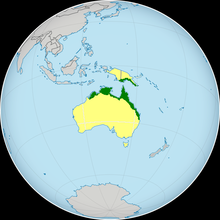Coastal Taipan
| Coastal taipan | |
|---|---|
 |
|
| Scientific classification | |
| Kingdom: | Animalia |
| Phylum: | Chordata |
| Subphylum: | Vertebrata |
| Class: | Reptilia |
| Order: | Squamata |
| Suborder: | Serpentes |
| Family: | Elapidae |
| Genus: | Oxyuranus |
| Species: | O. scutellatus |
| Binomial name | |
|
Oxyuranus scutellatus (W. Peters, 1867) |
|
 |
|
| Distribution of Oxyuranus scutellatus in green | |
| Synonyms | |
The coastal taipan (Oxyuranus scutellatus), or common taipan, is a species of large, highly venomous snake of the family Elapidae. It is native to the coastal regions of northern and eastern Australia and the island of New Guinea. According to most toxicological studies, this species is the sixth-most venomous land snake in the world based on its murine LD50.
Coastal taipans are large snakes. It is the largest venomous snake in Australia. Adult specimens of this species typically attains sexual maturity around 1.2 m (3.9 ft) in total length (body + tail). More mature specimens can grow to between 1.5 and 2.0 m (4.9 and 6.6 ft). Other taipans, including the inland taipan, attain broadly similar sizes although they tend to be slightly smaller in average size. A specimen of an average 2 m (6.6 ft) total length weighs around 3 kg (6.6 lb). According to the Queensland Museum, the longest recorded total length for the coastal taipan was a specimen that was 2.9 m (9.5 ft) and weighed 6.5 kg (14 lb). However, though exceptionally rare, much larger specimens are widely believed to exist, including specimens of as much as 3.3 m (11 ft). The taipan is exceeded in length among venomous snakes only by the Asiatic king cobra, African black mamba and genus Lachesis (bushmasters) of the American neotropics.
The head of this species is long and narrow like that of the African black mamba (but without the "coffin" shape). In fact, in several aspects of morphology, ecology and behaviour, the coastal taipan is strongly convergent with the black mamba (Dendroaspis polylepis). It has an angular brow and is lighter coloured on the face. The body is slender and colouration can vary. They are often uniformly light olive or reddish-brown in colour, but some specimens may be dark gray to black. The colouration is lighter on the sides of the body, and the ventral side (the belly) is usually a creamy-white to a pale light yellow in colour, and is often marked with orange or pink flecks. Individuals undergo a seasonal change in colour, becoming darker in winter and fading in summer. The eyes are large, round,and are light brown or even hazel in colour with large pupils.
...
Wikipedia
